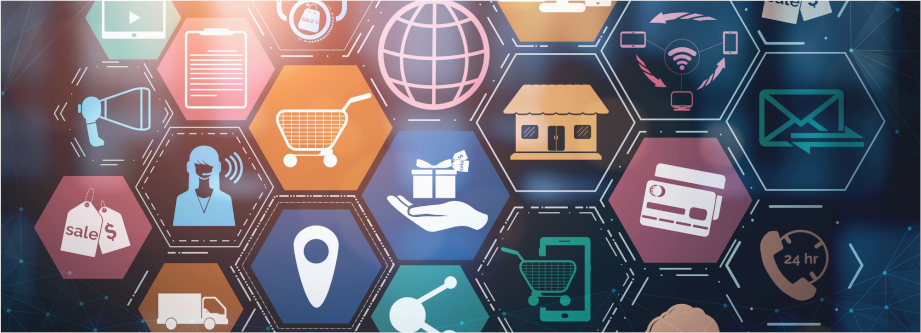
Table of Contents
Omnichannel marketing means creating a seamless experience and delivering a consistent brand message across all the channels where your customers are present. The approach has become so trendy because it really works. While many marketers are just planning to implement an omnichannel marketing strategy or taking the first steps in this direction, some companies have already trod the path to effective omnichannel marketing and proved it.
1. Disney
As you start your interaction with Disney, via their website or app, the magical experience starts to build. You can explore the park and plan what attractions, restaurants, and places you want to visit, and create your itinerary and wishlists. As you get to the park, you receive a multifunctional wrist band that opens your hotel room, and serves as a ticket to attractions and as a payment method.
The wristband is synchronized with the app and allows local photographers to identify you so that you can easily upload all your photos taken in the park. While you’re enjoying this seamless experience, Disney collects an incredible amount of data that allows the company to improve service even more. At the same time, visitors to Disneyland have no perception of intrusion or excessive marketing.
2. Nike
Nike balanced the digital and physical experience to amplify each other. Nike app builds a community of loyal customers. The company uses data collected in the app to personalize the experience which increases the consumer lifetime value. The customers share personal information like what sports they play and their preferences about Nike sub-brands, and products that interests them.
In general, NikePlus members buy three times more than an anonymous buyer.
The app allows customers to check product availability in their area, skip checkout lines and reserve products to pick up in-store. Nike is developing a technology for sizing footwear which will solve a painful problem for many customers.
3. Ikea
The Ikea app and print catalog provides an interconnected experience. Additionally, Ikea actively uses user-generated content and adds VR-functionality to their apps. An app user can scan the designated pages of a printed catalog and access the extended content. An augmented-reality “Place in Your Room” feature allows users to visualize items in their room.
In their mobile catalog app, you can save your favorite items to a shopping list to add to the cart later. The cart in the app and on the website is synchronized. The app also prompts users to share their videos and photos featuring Ikea products.
4. Walgreens
This pharmaceutical retailer allows its customers to make a digital appointment with a real doctor via their app and then, just collect the prescribed medication at the nearest Walgreens shop. It works really seamlessly. There is also a refill program, which ensures that you don’t have to remember to refill the prescription. You choose a convenient way to receive a notification when you need to refill and just collect it at the most convenient location.
Walgreens made an in-store service transformation and provided all their employees with the mobile connection to the company’s system so that they can promptly access accurate product information, check in-store availability and order when there’s no stock. A geofencing loyalty program provides push notifications of the loyalty points when you are near a Walgreens’ store. All the innovations are brought in as a response to customers’ needs so that the omnichannel customers are spending 6 times more than in-store consumers.
5. Sephora
The make-up giant, Sephora, develops tech solutions for beauty industry problems and delivers them via multiple channels in a seamless way. There are technologies to scan customers’ skin and select the best foundation, to find the shade you spotted in a picture, to make an appointment with a beauty consultant, and much more. The company develops an offline experience as well as the online presence. It offers workshops and makeovers in its stores and has touchscreens for even more convenient product testing. Its loyalty program also works across channels.
6. Walmart
Walmart’s omnichannel marketing strategy helps to grow its shoppers’ base. Walmart has actively increased its online grocery pickup points. It’s added mobile geofencing technology (linked with the loyalty program) that timeously alerts the retailer when a customer arrives to pick up an online order. Consumers can add items to the wishlist both from home or by scanning items in a store. Walmart is experimenting with driverless technology as a part of their omnichannel delivery initiatives. Customers can also return items via multiple channels. Recently, Walmart introduced 3D virtual shopping to make buying homeware more convenient.
7. Bloomingdale’s
Part of Macy’s Inc., this luxury department chain store, provides customers with convenient payment methods, shopBeacon, and smart fitting rooms, where customers can scan products to get more detailed product information. The shopBeacon is a mobile-location based technology delivering personalized recommendations, deals, discounts, and rewards.
Bloomingdale’s mobile app includes many omnichannel features such as
- the ability to order through the app with the same-day pick up in-store (you do this on the website as well);
- in-store notifications about nearby items on sale;
- “Scan & Send” to check the availability of items in required size and color in-store and order the delivery if necessary;
- a cross-channel loyalty program.
Also, Bloomingdale’s enhances the customer experience with the ability to book an appointment with a personal stylist, beauty consultant, or registry consultant online.
8. J.C. Penney
The J.C. Penney department store chain enhanced physical stores with digital assets allowing shop assistants to check product availability in all J.C. Penney stores and immediately place orders.
The J.C. Penney seamless experience includes:
- a buy online, pick up in-store program;
- pricing consistency across all channels;
- cross-channel returns;
- the fulfillment of online orders from the physical stores for last-mile delivery.
9. Lids
This retailer of sports apparel developed an omnichannel loyalty Access Pass. Its members enjoy special discounts, gifts, and early notifications on special offers. They can also earn reward points for both in-store and online purchases.
Another part of the omnichannel marketing strategy is the #LidsLoyal Instagram campaign. Customers are invited to share their photos wearing Lids merchandise. Each week, one of these pictures is chosen and reposted on the company’s feed, with products tagged for shopping. Lids also offers convenient cross-channel product returns.
10. Designer Brands
In 2018, Designer Brands relaunched its loyalty program which has improved according to the feedback. It allows customers to earn and redeem loyalty points across channels.
Designer Brands customers
- search for in-store products online;
- use a shared cart (can pick up shopping where they left);
- buy or reserve products online, try on/pick up in-store;
- note pricing consistency across channels.
The company has put many efforts and invested heavily in omnichannel technology to make shopping as convenient and seamless as possible.
11. Belk
This department store chain marketing seeks to improve the cross-device experience. Belk invests heavily in supporting its omnichannel marketing with technology. Its analytics solution, for example, helps forecast how much merchandise will be sold and makes sure that the stock is available. It offers the “buy online, pick up in-store” option. Belk’s marketing strategy includes opening new points of sale as well as developing its online presence.
12. Lane Bryant
This plus-size women’s apparel retailer developed an omnichannel mobile marketing campaign that won gold awards at the 2018 Mobile Marketing Association North America Regional Smarties event. Lane Bryant aims to maximally personalize its offers. Its omnichannel marketing includes buy online, pick up in-store options; loyalty rewards; the ability to browse and order items that are not sold in-store, and a shared cart.
13. UGG
This footwear brand allows customers to check the in-store availability of an item on their website. The brand also has a loyalty program where you can earn points for sharing and writing a product review, not just for purchasing. UGG experiments with its offline stores, enhancing them with tech. It provides detailed product information - through self-service or to shop assistants, who can now be even more helpful. It also provides personalized services, like customizing your future footwear look. UGG’s buy online, pick in-store options are excellent.
14. Neiman Marcus
ThIs luxury department store’s omnichannel marketing includes not only a seamless omnichannel experience but also cutting-edge tech and personalized services. The Memory Mirror technology, located in the physical stores, presents you with a 360-degree sharable video of yourself in a Neiman Marcus outfit. The Snap Find Shop feature will find an item on the website or in the app using the photo. The shop assistants have iPads connected to the company’s system so they can immediately provide accurate product information and check the customer’s preferences and purchase history.
15. Topshop
This fashion brand inspires customers to interact and engage with the brand across all channels and devices. Topshop provides engaging fashion content tailored to fit its omnichannel strategy, which is highly valued and shared by its customers. Highly functional mobile website and social media marketing boost sales, combined with convenient delivery options, in-store collection and order tracking.
16. MM.LaFleur
This Women’s clothing retailer offers its “bento box” subscription service online or in-store. It’s a collection of items curated for each customer after she completes a survey. The customer can keep the items she likes and send back the rest. Shoppers can also book appointments in MM.LaFleur’s stores and pop-ups. The same online survey data is used to create a curated closet, as an offline alternative to the “bento box”.
17. Net-a-Porter
A digital luxury fashion retailer, Net-a-Porter studied its customers’ behavior and discovered that most of them preferred print media (like fashion magazines). So they expanded their presence in this, unusual for a digital company, channel. The brand’s app The Net Set allows customers to interact with each other. Yoox Net-a-Porter Group is also known for creating a new omnichannel business model called Next Era. It improves customers’ experience through access to inventory across numerous fulfillment centers and stores.
18. Old Navy
This summer apparel brand rolled out an omnichannel strategy in 2018. The brand opened 60 new stores and, at the same time, decided to integrate their offline and online marketing efforts after testing the omnichannel approach small-scale. Now, its customers can check in-store availability of items online, select a “buy online, pick-up at store”, and use mobile checkout.
19. Value City Furniture
This furniture and homeware retailer uses an “Easy Pass” platform to enable its customers to start their journey in one channel and then seamlessly move to the other. Customers can make shopping lists online and the items will be waiting for them in a physical store. Customers starting in-store can access information like product dimensions and photos digitally and contact the sales associate they who helped them by email afterward.
20. Jysk
Another homeware goods supplier, Jysk, enhanced the in-store experience for its customers.
Specialized kiosk terminals installed across the stores provide product information and an online catalog containing an additional 20% of items. Jysk also expands delivery options and customer support to make the experience seamless.
These examples show that omnichannel marketing means focusing on the customer experience, and expanded the use of technology. The technologies collect unified data and create personalized services for wow-effect. An omnichannel marketing strategy should also include increased delivery options, buy online, pick up in-store capabilities, online and offline data integration, a shared cart across channels, and omnichannel loyalty programs.


